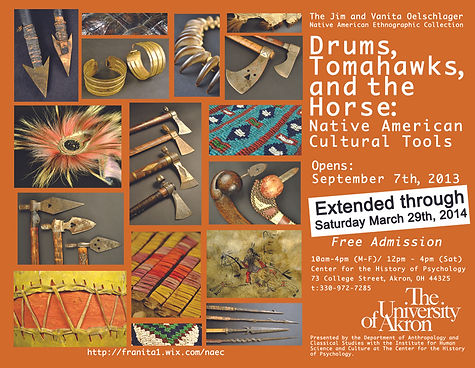The Jim and Vanita Oelschlager
Native American Ethnographic Collection
"Drums, Tomahawks, and the Horse: Native American Cultural Tools"

This exhibition features drums, tomahawks, shields, headdresses, and other tools related to Native American life and the use of the horse. It highlights artistic expression in objects as beaded moccasins, painted buffalo robes, decorations with porcupine quills, and ledger drawings.
These cultural artifacts represent tools used during the late 1700s to the early 1900s; they are placed in an historical context with prehistoric and historic maps and timelines of selected events of change in the lives of Native Americans.
 |  |
|---|---|
 |  |
 |  |
 |  |
 |  |
 |  |
 |  |
 |  |
 |  |
 |  |
 |  |
 |  |
 |  |
 |  |
 |
This exhibition is framed in the context that these cultural artifacts are tools: they are tools for everyday living, for ceremony, for warfare, and for artistic expression. These objects were created by the people of the Great Plains and western Great Lakes from about 1860 to 1920. The objects are part of long cultural traditions and were used to hunt, to defend themselves, to fight Europeans and other tribes, and to trade.
As you travel through the time periods and geography of this exhibition, note that the tools are ethnographic, meaning that they were made for specific purposes. When Native American life changed dramatically after European conquest and colonization, the tools manufactured also demonstrated the Native adaptation to new materials such as metal and wool.
The focus in this exhibition is three-fold. First, consider the abundant natural resources in what we call North America before the early European contact. Remember the huge diversity of cultures, languages, and environments. Then note the changes brought about by introduction of metal and the horse. But critical to Native American history is the fact that a population of around ten million people was reduced to nearly half by epidemics of new diseases brought by traders and colonists. Each trading contact, each explorer, and each military group brought new exposure to the people. So even as the new tools were accepted and used, the cultures were weakened.
The tools you see here represent a long period of contact between Europeans and Native Americans and illustrate both trade and changing life situations, from free peoples in their own lands to living on government reservations. The new tools brought different technology. Tools, such as metal axe heads, (tomahawk) were introduced by European traders in exchange for furs, and this new trade item replaced the use of stone axes. Later however, many of these earlier styles became important for trade, often made specifically as cultural artifacts for collections.
All these objects are “real” but many types of tools made before 1890 were no longer useful in reservation life, since buffalo hunting was forbidden and Native American tribes were no longer free to govern themselves. These post-Battle of Wounded Knee (1890) cultural objects were made for ceremonies that reinforced cultural values and passed traditional skills to the next generation. And, they were made to sell to collectors, art galleries, museums, and the public.
The exhibition begins with a map, “Peopling of the Americans.” It includes concepts about how people came to the Americas and it is based upon archaeological research. The second map, “European Contact and Colonization,” provides a visual representation of the dates of contact and resources present in North America. It begins to focus on the Great Plains and Great Lakes. The third map, “Culture Change” illustrates the connections between what were the many Native American cultures and the new diseases, tools, and ideas brought by the Europeans from about 1700 to the 1890. The 1890 to 1920 period of broken treaties and reservations brought more change and great hardships. By 1920 positive changes occurred with citizenship, greater tribal control, social movements, and protective laws.